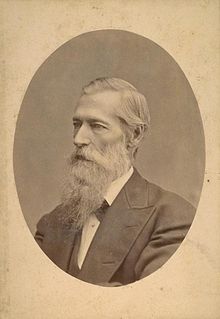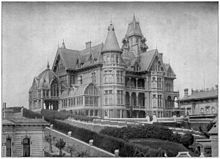- Mark Hopkins, Jr.
-
Mark Hopkins 
Photo by I. W. TaberBorn September 1, 1813
Henderson, New YorkDied March 29, 1878 (aged 64)
Yuma, ArizonaMark Hopkins (September 1, 1813 – March 29, 1878) was one of four principal investors who formed the Central Pacific Railroad along with Leland Stanford, Charles Crocker, and Collis Huntington in 1861.
Contents
Early years
Hopkins was born in Henderson, Jefferson County, New York to Mark Hopkins and Anastasia Lukens Kellogg, who were first cousins. Because his father died when he was a boy, he was never known as "Junior." The family moved to St. Clair, Michigan in 1824. His father, Mark Hopkins (1779–1828), served as Postmaster, first in Henderson, NY, then in St. Clair, MI (known then as Palmer), where he was also Judge of Probate.[1]
The elder Hopkins died in 1828, and his son left school to work as a clerk. In 1837 he studied law with his brother Henry, but moved on through several business ventures. He was a partner in a firm called "Hopkins and Hughes", then a bookkeeper and later manager for "James Rowland and Company".
California
When the California Gold Rush began, Hopkins formed the "New England Mining and Trading Company", a group of 26 men each of whom invested $500 to purchase goods and ship them to California for sale. On January 22, 1849 Hopkins left New York City on the ship Pacific. After rounding Cape Horn, the ship arrived in San Francisco on August 5, 1849.
Hopkins opened a store in Placerville, California but it did not succeed and he relocated to Sacramento where he opened a wholesale grocery in 1850 with his friend Edward H. Miller. Miller would later be secretary of the Central Pacific Railroad.
On September 22, 1854 in New York City, Hopkins married his first cousin, Mary Frances Sherwood. Though his background was Congregationalist, the wedding was at a Presbyterian Church.
In 1855, Hopkins and Collis P. Huntington formed "Huntington Hopkins and Company" to operate a hardware and iron business in Sacramento.
In 1861, as part of The Big Four, he founded the Central Pacific Railroad. Sometimes called "Uncle Mark", he was the eldest of the four partners and was well known for his thriftiness (it was said that he knew how to "squeeze 106 cents out of every dollar",[2] a reputation that gained him the post of company treasurer. Noted American historian Hubert Howe Bancroft quotes Collis Huntington as saying, "I never thought anything finished until Hopkins looked at it". Bancroft described Hopkins as the "balance-wheel of the Associates and one of the truest and best men that ever lived." A Whig and later associated with the Free Soil Party, Hopkins was an Abolitionist and an organizer of the Republican Party in California.
Despite his thriftiness, his wife managed eventually to persuade him to build an ornate mansion at the top of Nob Hill in San Francisco, California, close to the mansions of other Central Pacific founders. The construction commenced in 1875. The architects were the prominent San Francisco firm of Wright and Sanders and the project manager was architectural engineer William Wallace Barbour Sheldon, who worked for Hopkins under the Southern Pacific Improvement Company.
By then Hopkins was having health problems, and died aboard a company train near Yuma, Arizona in 1878, the house not yet completed. Eventually finished and occupied by Mary, the structure burned to the ground in a fire caused by the 1906 San Francisco earthquake. The Mark Hopkins Hotel (currently InterContinental Mark Hopkins San Francisco) was built in its place in 1926.
Hopkins is buried in Sacramento Historic City Cemetery (aka Old City Cemetery) in Sacramento, California.[3]
Legacy
Mark and Mary Hopkins did not have any children, and Hopkins died without having left a will. After Mark Hopkins' death, his estate passed to Mary, who adopted her housekeeper's adult son, Timothy Nolan, who thus became Timothy Hopkins. Mary later disinherited Timothy Hopkins, and went on to marry Edward Francis Searles. After her death, Timothy sued for and was awarded some of the estate, but the bulk of it passed to Searles.
References
- ^ Hopkins, Timothy (1932). John Hopkins of Cambridge, Massachusetts, 1634, and Some of His Descendants. Stanford, CA: Stanford University Press. p. 304.
- ^ Yenne, Bill (1985). The History Of The Southern Pacific. Bison Books Corp. p. 11. ISBN 0-517-46084-X.
- ^ Self Guided Tour. Historic City Cemetery, Inc.. January 2006. http://www.oldcitycemetery.com/images/PDF/SelfTour.pdf. Retrieved January 29, 2011.
Further reading
- Ambrose, Stephen E. (2000). Nothing Like It In The World; The men who built the Transcontinental Railroad 1863-1869. Simon & Schuster. ISBN 0-7432-0317-8.
- Findagrave.com, Mark Hopkins. Retrieved December 13, 2005.
- Genealogy of Mark HOPKINS & Mary Frances SHERWOOD.
- Galloway, John Debo; Chapter Four (1950). The First Intercontinental Railway. New York: Simmons-Boardman. OCLC 491805. http://cprr.org/Museum/Galloway4.html. Retrieved 15 September 2010.
Central Pacific Railroad · The Big Four Charles Crocker · Mark Hopkins, Jr. · Collis Potter Huntington · Leland Stanford
Categories:- 1813 births
- 1878 deaths
- People from Jefferson County, New York
- 19th-century American railroad executives
- Businesspeople from California
- Jefferson County, New York
- Robber barons
- California Whigs
- California Republicans
- California Free Soilers
- People of Upstate New York
Wikimedia Foundation. 2010.

